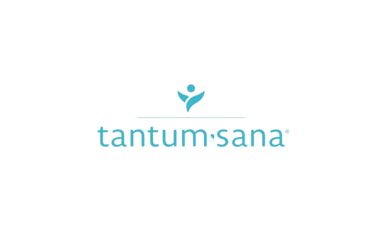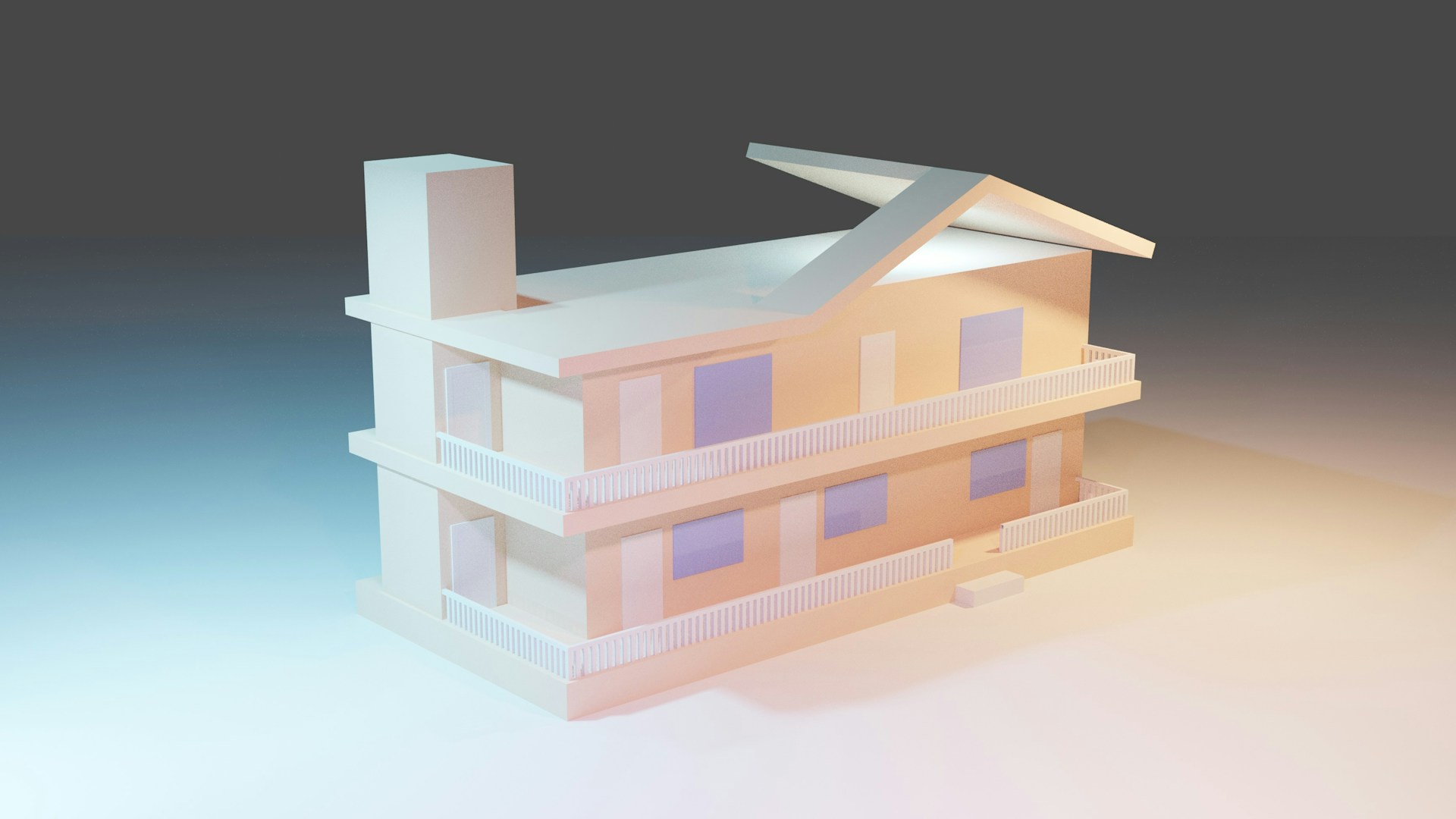
Definition: PropTech large-scale property management combines advanced technology with traditional real estate operations to handle extensive property portfolios efficiently across multiple locations and property types.
This article explores how modern large-scale property managers can leverage artificial intelligence, automation, and data analytics to scale their operations, reduce administrative costs, and improve tenant satisfaction across large property portfolios. You will discover proven implementation strategies, ROI metrics, and emerging technologies that transform property management from reactive to predictive operations. Learn about financial integration systems, predictive maintenance applications, and tenant management automation that leading companies use to maintain competitive advantages in today’s market.
Key takeaways
- PropTech large-scale property management reduces administrative tasks by up to 40% through automation and centralized operations
- Smart property management platforms integrate financial operations with tenant management for complete portfolio oversight
- AI property management software enables predictive analytics that increase tenant retention rates by 15-20%
- Real-time property analytics provide actionable insights for pricing optimization and strategic decision-making
PropTech large-scale property management: The complete overview
Large property portfolios present unique challenges that manual systems cannot handle effectively. Companies managing 100 or more properties across multiple markets often face coordination nightmares, data inconsistencies, and operational bottlenecks.
Traditional approaches struggle to manage hundreds of different lease agreements, renewal dates, and tenant requirements. Property managers spend 60% of their time on administrative tasks instead of strategic activities.
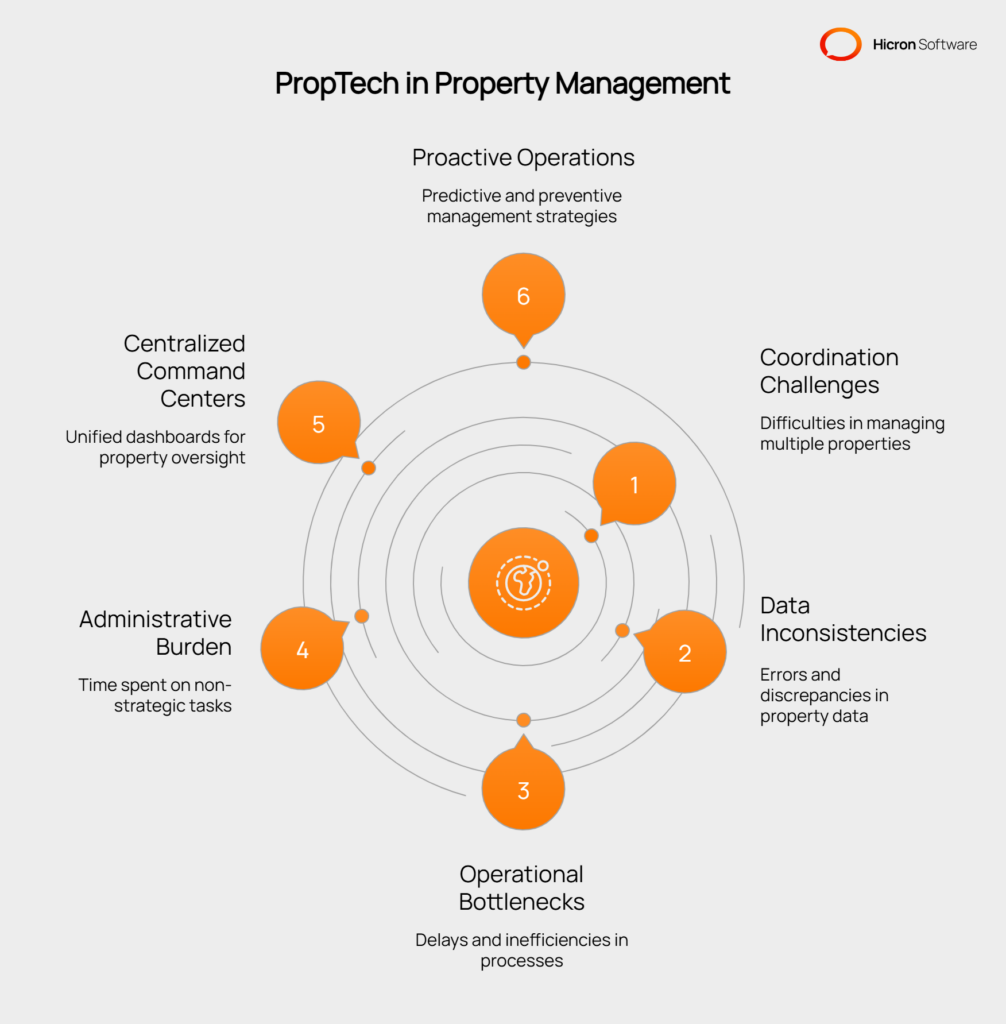
Modern PropTech solutions eliminate these inefficiencies by creating centralized command centers for portfolio management. Property managers can monitor occupancy rates, track maintenance requests, and review financial performance across all properties from unified dashboards.
The technology transforms property management from reactive to proactive operations. Instead of responding to problems after they occur, smart systems predict issues and enable preventive actions that reduce costs and improve tenant satisfaction.
Smart property management platforms for modern portfolios
Modern smart property management platforms serve as centralized command centers for large-scale operations. These systems integrate multiple functions into unified dashboards, providing complete portfolio oversight.
Cloud-based systems enable remote access from any location, supporting distributed teams and multi-market operations. Property managers can monitor all properties from a single interface while maintaining detailed records for each location.
Cloud-based property management features
Cloud platforms offer several advantages over traditional on-premise systems. They provide automatic updates, enhanced security, and scalable storage that grows with portfolio expansion.
Data synchronization happens automatically across all connected systems. When tenants submit maintenance requests through mobile apps, the information instantly appears in management dashboards and vendor portals.
Digital property management tools integration
Integration capabilities determine the effectiveness of a platform for managing large portfolios. Leading systems connect with accounting software, maintenance management tools, and marketing platforms through APIs.
Modern platforms support single sign-on authentication, allowing staff to access multiple systems without repeatedly entering credentials. This streamlined access improves productivity and reduces security risks.
Document management systems store lease agreements, inspection reports, and financial records in searchable digital formats. OCR technology converts paper documents into searchable text, making historical information instantly accessible and searchable.
Tenant management automation capabilities
Automated tenant management handles routine interactions while maintaining personalized service quality. These systems manage complete tenant lifecycles from application to move-out.
Communication automation includes rent reminders, maintenance updates, and lease renewal notifications. Multi-channel delivery through email, SMS, and mobile app notifications ensures tenants receive important information promptly.
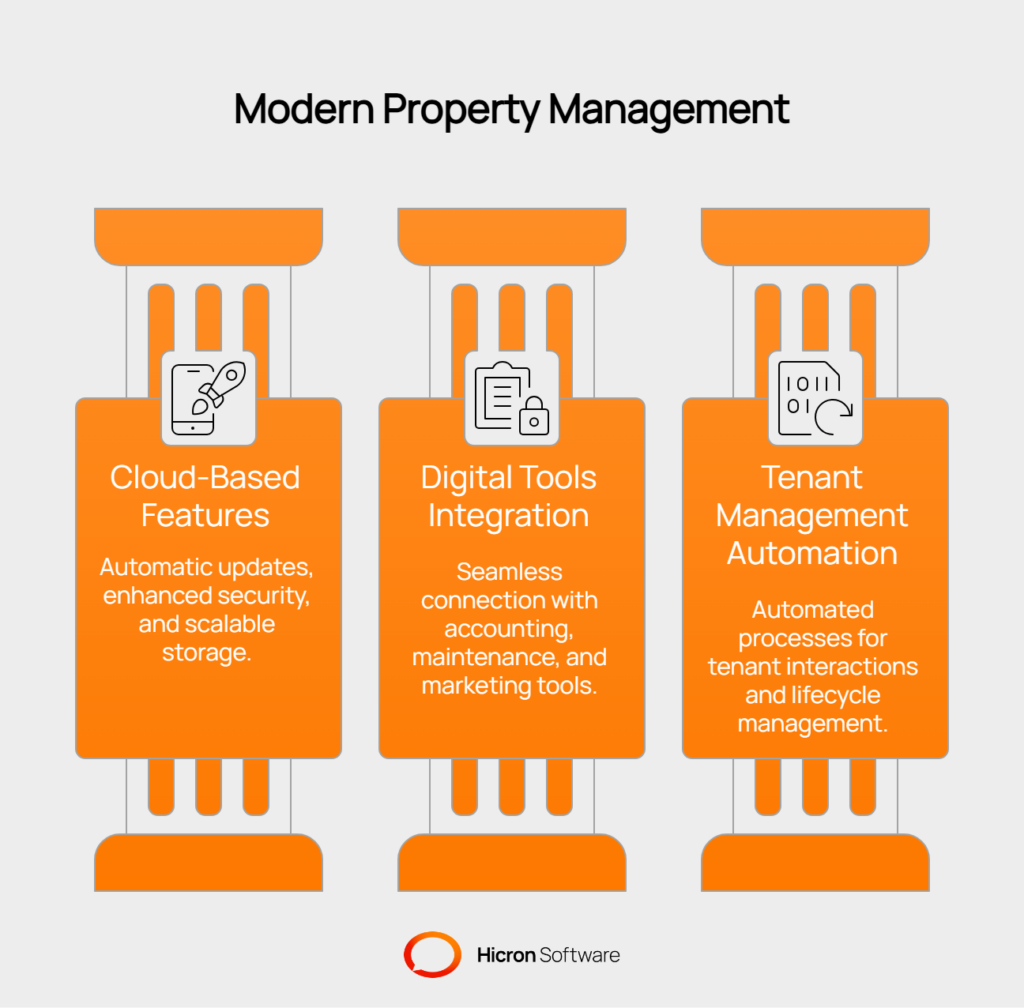
AI property management software applications
Artificial intelligence transforms property management from reactive to predictive operations. AI systems analyze vast amounts of data to identify patterns, predict outcomes, and recommend optimal strategies.
Machine learning algorithms continuously improve their accuracy by learning from new data and outcomes. These systems become more valuable over time as they process more information about tenant behavior, market conditions, and operational patterns.
Predictive maintenance real estate applications
Predictive maintenance systems analyze equipment performance data, maintenance histories, and environmental factors to predict failures before they occur. This approach reduces emergency repairs by 40% and extends equipment lifespan by 20-25%.
IoT sensors throughout buildings monitor temperature, humidity, energy consumption, and equipment performance. Data feeds into AI algorithms that identify patterns indicating potential problems.
Maintenance scheduling optimization minimizes tenant disruption while maximizing equipment reliability. Systems recommend optimal timing for repairs and replacements based on usage patterns and seasonal factors.
IoT property management systems
Internet of Things devices enable smart buildings to monitor themselves continuously. Sensors track energy usage, water consumption, security breaches, and environmental conditions.
Smart thermostats adjust temperatures based on occupancy patterns and weather forecasts. Lighting systems in vacant areas turn off automatically, reducing energy costs by 15-30%.
Water leak detection systems shut off supply lines automatically when sensors detect unusual flow patterns. Early detection prevents property damage and reduces insurance claims.
Financial integration of property tech solutions
Financial integration connects every transaction with operational activities, providing real-time visibility into portfolio performance. When tenants pay rent through platforms, systems automatically update financial reports and cash flow projections.
Automated revenue tracking includes rent payments, late fees, and additional charges across all properties. Integration with banking systems enables instant payment processing and automatic reconciliation.
Expense allocation systems calculate common area maintenance charges based on lease terms and actual usage data. Transparent reporting builds tenant trust and reduces billing disputes.
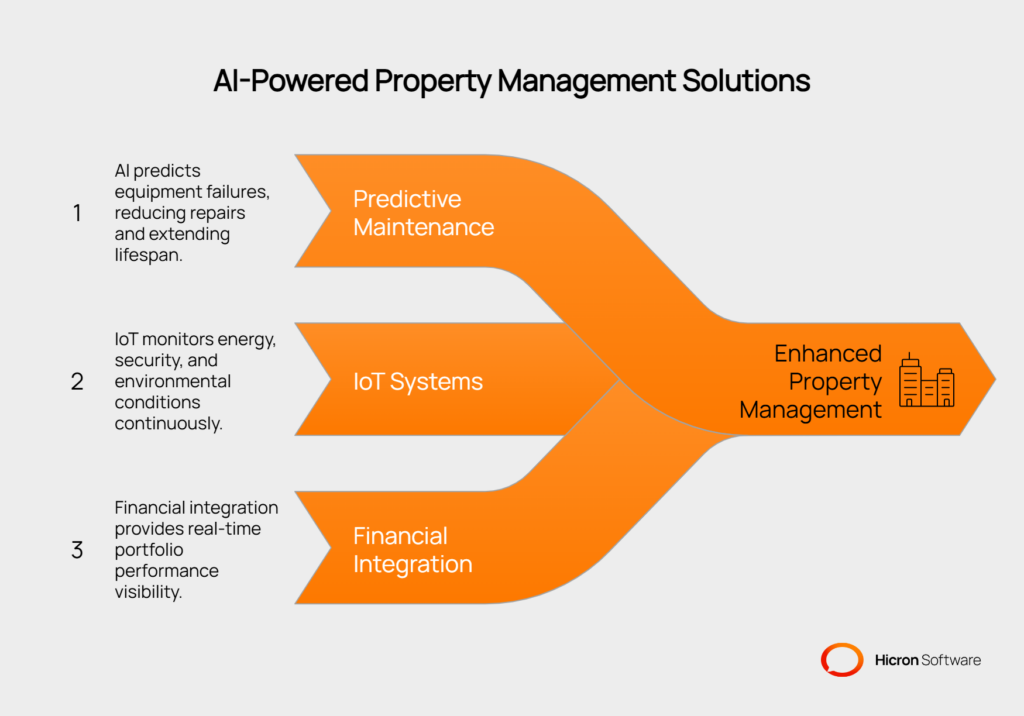
Automated property management systems implementation
Successful implementation requires careful planning and phased rollouts across large portfolios. Most companies adopt staged approaches, starting with core functions before expanding to advanced features.
Property portfolio management software setup
Initial setup involves data migration from legacy systems, staff training, and system configuration. Property managers often discover incomplete records and inconsistent data formats during migration processes.
Data cleaning protocols validate the accuracy of information before importing it into new systems. Parallel system operation during transition periods ensures business continuity while staff learn new processes.
Integration testing verifies that connections between different software components work correctly. This includes accounting systems, maintenance management tools, and tenant portals.
Implementation best practices
Change management strategies address staff resistance by involving employees in the selection process and highlighting the personal benefits. Regular communication about implementation progress maintains engagement.
Pilot programs test systems with small property groups before full rollouts. This approach identifies potential issues and allows refinement before company-wide deployment.
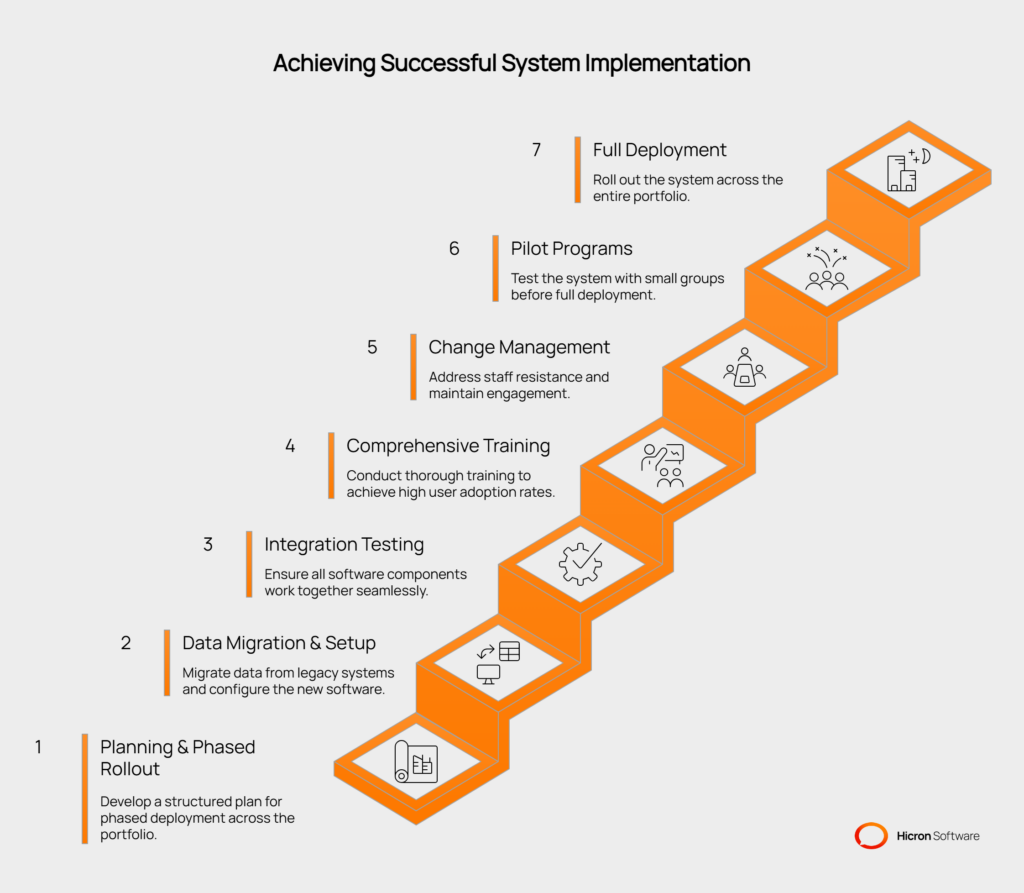
Real-time property analytics and performance tracking
Real-time analytics transform decision-making by providing instant access to critical performance metrics. Property managers can identify trends, spot problems, and capitalize on emerging opportunities.
Modern dashboards display key performance indicators in visual formats that enable quick understanding of complex data. Customizable views allow different stakeholders to focus on metrics most relevant to their roles.
Data-driven decision-making tools
Analytics platforms aggregate data from multiple sources, including rent rolls, maintenance systems, and market research. Machine learning algorithms identify patterns and correlations that human analysis might miss.
Predictive models forecast occupancy rates, maintenance costs, and market trends based on historical data and current conditions. These insights enable proactive rather than reactive management strategies.
Automated alerts notify managers when metrics exceed predetermined thresholds. Early warning systems prevent small issues from becoming major problems.
Performance metrics and KPIs
Key performance indicators include occupancy rates, average rent per square foot, maintenance response times, and tenant satisfaction scores. Tracking these metrics enables data-driven optimization strategies.
Financial performance metrics encompass net operating income, cash flow, and return on investment calculations. Real-time visibility enables immediate responses to changing conditions.
Operational efficiency measurements include maintenance costs per unit, leasing velocity, and staff productivity metrics. These insights guide resource allocation and process improvements.
Scalable large-scale property management solutions for growth
Scalability becomes critical as portfolios expand beyond local markets. Systems must handle increased data volumes, user counts, and transaction processing without performance degradation.
Cloud-based architectures offer elastic scaling, which automatically adjusts resources in response to demand. This ensures consistent performance during peak usage periods without incurring unnecessary costs for unused capacity.
Multi-property oversight systems
Centralized oversight eliminates the need for separate systems at each property location. Single dashboards provide visibility into entire portfolios while maintaining property-specific details.
Role-based access controls ensure staff can access information relevant to their responsibilities without compromising security. Site managers see their properties while executives view portfolio-wide summaries.
Standardized processes across properties improve efficiency and enable staff mobility between locations. Consistent procedures reduce training requirements and ensure service quality.
| Management Aspect | Traditional Approach | PropTech Solution | Efficiency Gain |
| Lease Management | Manual tracking | Automated reminders | 60% time savings |
| Financial Reporting | Monthly compilation | Real-time dashboards | 75% faster reporting |
| Maintenance Coordination | Phone and email | Integrated platforms | 50% response improvement |
| Tenant Communication | Individual messages | Automated notifications | 80% administrative reduction |
Centralized operations management
Operations centers monitor multiple properties from single locations, reducing overhead costs and improving response coordination. Remote management capabilities enable 24/7 oversight without on-site staff.
Vendor management systems coordinate service providers across entire portfolios. Standardized contracts and performance metrics ensure consistent service quality while enabling volume discounts.
Emergency response protocols route urgent issues to appropriate personnel based on location, expertise, and availability. Automated escalation ensures critical problems receive immediate attention.
Property management technology ROI and benefits
Technology investments require careful measurement to justify costs and guide future decisions. Successful companies track multiple metrics that demonstrate value across different operational areas.
Direct benefits include reduced labor costs through automation, lower maintenance expenses through predictive systems, and increased revenue from optimized pricing. Indirect benefits encompass improved decision-making and enhanced tenant satisfaction.
| ROI Category | Key Metrics | Typical Improvements | Timeframe |
| Administrative Efficiency | Hours saved per property | 40-60% reduction | 3-6 months |
| Tenant Retention | Renewal rates | 15-25% improvement | 12-18 months |
| Maintenance Costs | Emergency repairs | 30-50% reduction | 6-12 months |
| Revenue Optimization | Rent per square foot | 3-7% increase | 6-12 months |
Companies typically achieve a positive ROI within 12-18 months of implementation, with benefits accelerating as the systems mature and staff expertise increases. Implementation costs range from $50-200 per unit, depending on system complexity and customization requirements.
Long-term benefits include improved competitive positioning, enhanced scalability, and reduced regulatory compliance risks. These strategic advantages often exceed direct cost savings in overall value creation.
Summary: Getting started with PropTech implementation
PropTech large-scale property management requires strategic planning and systematic execution to achieve operational excellence across extensive real estate portfolios. Companies that approach implementation methodically consistently achieve better outcomes and faster returns on investment compared to those using ad-hoc deployment strategies.
The foundation of successful PropTech adoption begins with conducting comprehensive assessments of current systems, identifying operational pain points, and defining clear success metrics. Early stakeholder engagement is critical for ensuring organizational buy-in and smooth technology adoption throughout the implementation process.
Partnering with experienced PropTech providers who understand the complexities of large portfolio management becomes essential for long-term success. Companies should prioritize vendors with proven track records, comprehensive training programs, and robust support systems that guide both initial implementation and ongoing optimization efforts.
Hicron Software specializes in delivering tailored PropTech solutions designed specifically for large-scale property management operations. With extensive experience in portfolio management complexities, we provide strategic guidance, technical expertise, and ongoing support to ensure successful technology adoption. Our approach helps property management companies achieve faster ROI while maintaining exceptional tenant service standards.
The future belongs to property management companies that embrace advanced technology while maintaining focus on exceptional tenant service. PropTech provides the essential tools to achieve both objectives, creating operational excellence that drives profitability and sustainable growth across entire portfolios.
For expert guidance on PropTech implementation and customized solutions for large-scale property management, contact us to discover how our methodologies can transform your operations.
FAQ
What is the average implementation timeline for PropTech solutions across large portfolios?
Complete implementation usually takes 6-12 months for portfolios with 100+ properties. Phased rollouts, starting with core functions, allow for gradual staff training and system optimization while maintaining operational continuity throughout the transition process.
How do PropTech platforms handle data security and compliance requirements?
Leading platforms use enterprise-grade encryption, regular security audits, and compliance with regulations like GDPR and CCPA. Multi-factor authentication and role-based access controls protect sensitive tenant and financial data from unauthorized access.
Can existing accounting and maintenance systems integrate with new PropTech platforms?
Modern property management platforms offer APIs and integration capabilities for most major systems. However, legacy software may require custom development work or data migration to ensure smooth connectivity and data synchronization.
What training requirements should companies expect during PropTech implementation?
Successful implementations typically require 20-40 hours of initial training per user, plus ongoing education as new features are added. Companies with comprehensive training programs achieve significantly higher user adoption rates and system utilization.
How can property managers measure ROI from PropTech investments?
ROI measurement should include direct benefits like reduced labor costs and increased revenue, plus indirect benefits such as improved decision-making and tenant satisfaction. Most companies see positive returns within 12-18 months through operational efficiency gains and revenue optimization.
Testimonials
Get in touch


